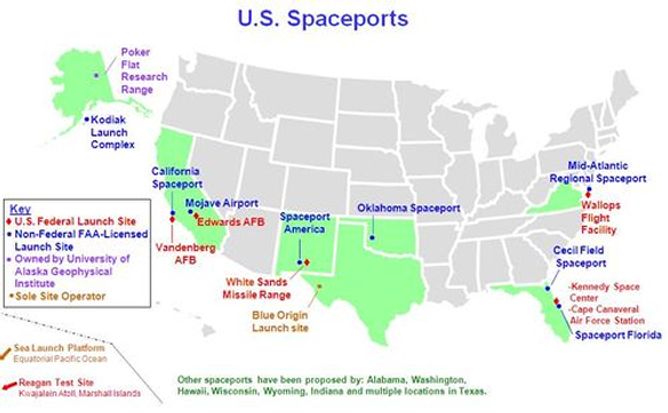Last month a colleague of mine and I visited with Dennis Heap, Executive Director of the National Front Range Airport, at Watkins, CO, the location of the future Spaceport Colorado, and Colorado’s contribution to getting into space. Here is Part 2.
What is a spaceport?
Wikipedia gives a very broad definition of a spaceport, that anything and everything that is used to launch vehicles into orbit, space and interplanetary missions are now termed spaceports. ICBM sites are termed launch sites. There is, however, a distinction between a military site and a commercial site. In the aviation world a military site is termed an ‘airbase’ while a commercial civilian site is termed an ‘airport’. Similarly in the marine world the respective terms are ‘naval base’ and ‘seaport’. In that vein there are ‘spacebases’ and ‘spaceports’. So bear in mind that not everything that is labeled a ‘spaceport’ is one.
As far as I can remember the term ‘spaceport’ caught the public’s imagination only recently with the advent of Spaceport America at Las Cruces, NM. So let’s clarify. A spaceport is port for launching vehicles into suborbital, orbital and interplanetary space whose primary mission is to support and manage commercial activities, not military, not government sponsored launches. And therefore, in the United States there are only 10 existing or proposed spaceports. They are (1)Mid-Atlantic Regional Spaceport, Wallops Island, VA (2)Cecil Field Spaceport, Jacksonville, FL (3)Spaceport Florida, Cape Canaveral (4)Spaceport Oklahoma, Burns Flat, OK (5)Spaceport America, Las Cruces, NM (6)Mojave Air and Spaceport, Mojave, CA (7) California Spaceport, Vandenberg Air Force Base, Lompac, CA (8)Kodiak Launch Complex, Kodiak Island, AK, (9) Spaceport Colorado, Watkins, CO and (10)Spaceport Hawaii, HI.
Map of US Spaceports as of Aug 26, 2011, Courtesy of US Department of Transportation.
The proposed spaceports outside of the United States that interest me are Spaceport Sweden, Spaceport Singapore, and Ras Al Khaimah Spaceport, UAE. Spaceport Sweden is the only one of the three that shows some form of life. The other two appear to be dormant with no signs of life. If one were to compare business concepts, Spaceport Sweden is closer to Spaceport America and Spaceport Singapore is similar to Spaceport Colorado.
Spaceports, real people doing real things to get into space.
—————————————————————————————————
Benjamin T Solomon is the author & principal investigator of the 12-year study into the theoretical & technological feasibility of gravitation modification, titled An Introduction to Gravity Modification, to achieve interstellar travel in our lifetimes. For more information visit iSETI LLC, Interstellar Space Exploration Technology Initiative.
Solomon is inviting all serious participants to his LinkedIn Group Interstellar Travel & Gravity Modification.




